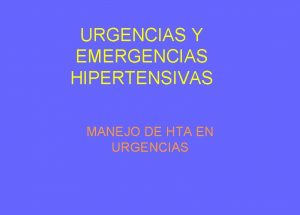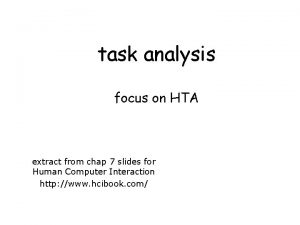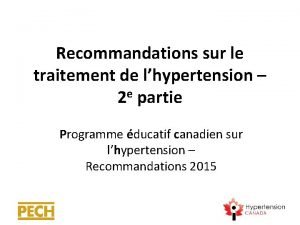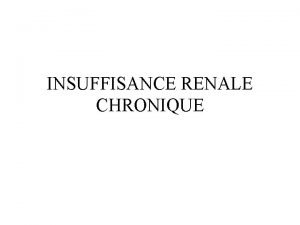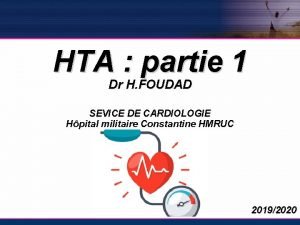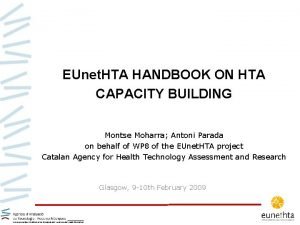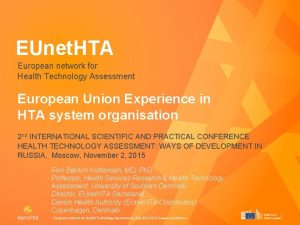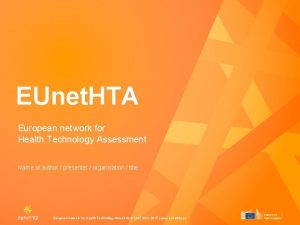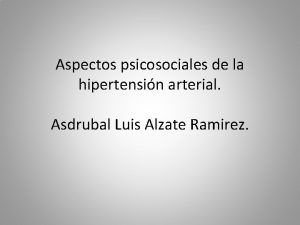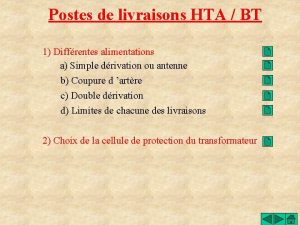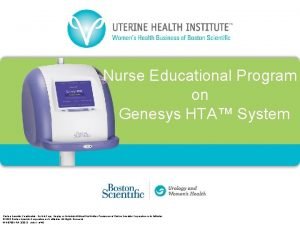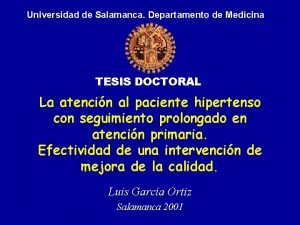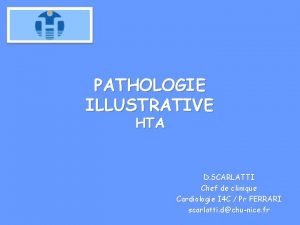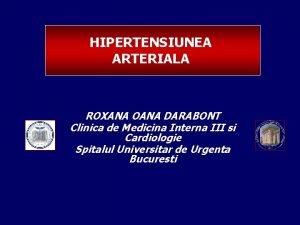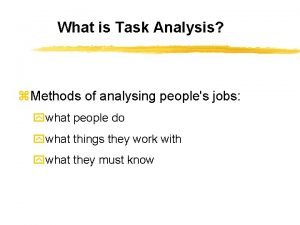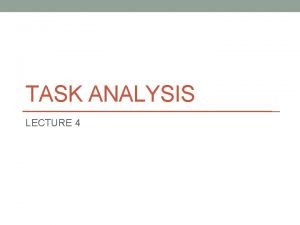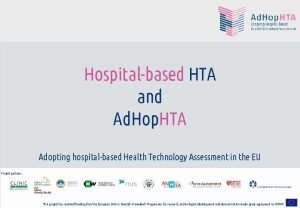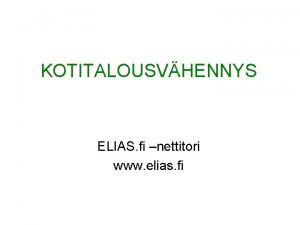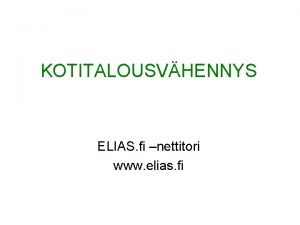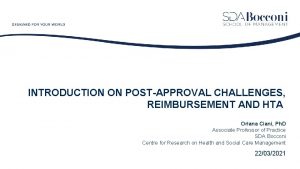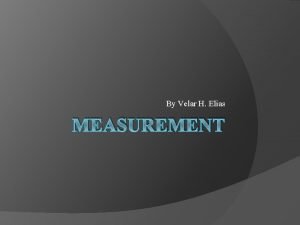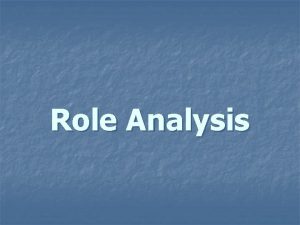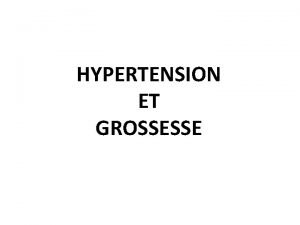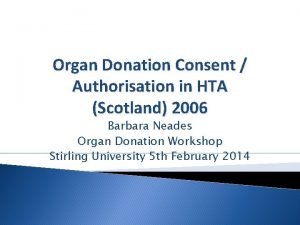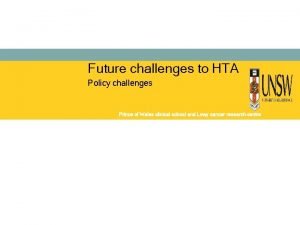An introduction to the role of HTA Elias




















![Coverage restrictions for eligible anticancer drugs, FDA approved 2004 -2008 CMS [N=59] VA [N=59] Coverage restrictions for eligible anticancer drugs, FDA approved 2004 -2008 CMS [N=59] VA [N=59]](https://slidetodoc.com/presentation_image_h/201dda52c4a71528c4796623054e638f/image-21.jpg)

- Slides: 22

An introduction to the role of HTA Elias Mossialos Professor of Health Policy, London School of Economics

Health Technology Assessment (HTA) is a multi-disciplinary field of policy analysis, which studies the medical, social, ethical and economic implications of development, diffusion and use of health technology.

Role of HTA in HC Innovation and Financing l – HTA systems seek to ascertain the relative effects of technology on health, the availability and distribution of resources, and other aspects of the health system. – Helps to identify both cost-effective and cost-ineffective technologies and health services. HTA provides a range of stakeholders with evidence-based information for decision-making (e. g. , reimbursement, pricing) and priority-setting. – Serves as a bridge between science and decision-making.

Governance of HTA in Europe l l l In the EU, programmes for HTA have been established via provision of new agencies/institutes or in existing academic or governmental entities. Many countries have several bodies dedicated to HTA, with somewhat unclear and disparate roles and responsibilities. Heterogeneity of existing HTA bodies reflects the differentiated environments of European health care systems. Austria Federation of Austrian Social Insurance Institution/Drug Evaluation Committee Belgium National Institute for Sickness and Invalidity Insurance/Commission for Reimbursement for Medicines Denmark Reimbursement Committee/Danish Centre for Health Technology Assessment Finland Germany Netherlands Pharmaceuticals Pricing Board (PPB)/Fin. OHTA Federal Joint Committee/Institute for Quality and Efficiency in Health Care/ German Agency for Health Technology Assessment (DAHTA) National Health Insurance Board/Committee for Pharmaceutical Aid/Health Council Norway Pharmaceuticals Pricing Board/Norwegian Centre for Health Technology Assessment Sweden Pharmaceutical Benefits Board (TLV)/Swedish Council on Technology Assessment in Health Care (SBU) Switzerland Swiss Federal Office of Public Health/Confederal Drug Commission/Swiss Network for HTA United Kingdom National Institute of Health and Clinical Excellence (NICE)/National Coordinating Centre for Health Technology Assessment (NCCHTA)/Scottish Medicines Consortium (SMC)

Responsibility and Membership of HTA Entities (1) l Most national HTA bodies can be categorised as serving an advisory, regulatory, or coordination role. – – – Advisory = render reimbursement or pricing recommendations to a national or regional gov’t, a ministerial department, or self-governance body (e. g. , Netherlands, Demark). Regulatory = accountable principally to health ministries; assume primary responsibility for the listing and pricing of drugs, medical devices, and other related services (e. g. , Finland, France, Sweden – LFN). Coordination = responsible for coordinating HTAs and/or developing clinical guidance, and producing and disseminating reports (e. g. , Sweden – SBU).

Responsibility and Membership of HTA Entities (2) l Most HTA bodies either conduct the assessment in-house or contract independent reviews to external organisations (e. g. , academic research institution) l Use of independent reviews presents both advantages and challenges – – + (lends to greater transparency, helps prevent or resolve potential appeals, widens available expertise, and brings broader perspectives to process) - (introduces disconnects between methodological approaches, coordination inefficiencies, and divergent agendas)

Range of Technologies Evaluated l In several countries, the HTA effort focuses on medicines, usually because of the remit the HTA entity has been given (eg the Cv. Z in the Netherlands) l Consideration of a broader range of technologies is more likely to lead to overall efficiency and gives a ‘level playing field’ (eg NICE)

Topic Selection (1) l Topic agendas are often set by national authorities (i. e, Mo. H), Ministries of Health, or expert committees affiliated with an HTA body. – l Various stakeholders (e. g. , industry, patient representatives, providers) may submit topic suggestions or comment on priorities, although the extent of engagement various by country. While selection criteria differs across review body, they typically include health benefit, disease burden, resource impact, innovation capacity, clinical and political relevance, and feasibility of assessment.

Topic Selection (2) l Several agencies have developed “early warning” or “horizon scanning” systems to identify new and emerging technologies that might require early or urgent evaluation. – – Netherlands, Sweden, Finland, the UK have established such programmes Internationally connected via Euro. Scan Network l Many HTA agencies lack explicit and transparent processes for prioritisation, including selection methods and stakeholder involvement. l More emphasis should be placed on identifying topics for potential disinvestment.

Types of Evidence Considered l For clinical evidence, some entities (eg IQWi. G in Germany) place a major emphasis on RCTs l Others (eg NICE) recognize the relevance of observational data and economic modelling l Very few entities pay much attention to items such as productivity gains, or patient/family costs (Sweden is an exception)

Analytical Design l While almost all countries firstly consider therapeutic benefit, other factors frame the analysis: – – – l l Disease burden Patient quality of life (Qo. L) Cost-effectiveness Costs Budget impact Availability of alternative treatments Health-related Qo. L is deemed the most appropriate criterion for a technology’s added value from the patient perspective. To a lesser extent, level of innovation, equity, and social and ethical implications are considered.

Assessment Methods (1) l Cost-effectiveness (CE) and comparative clinical effectiveness are most often considered appropriate approaches for assessing relative benefits (and costs).

Assessment Methods (2) l All countries deem RCTs the most reliable and objective evidence to classify product benefit. Demonstrate safety, clinical effectiveness, adverse effects, possible risks – l Even where definitive primary studies exist, however, there are limitations to reliance on such evidence. – – l Preference is toward RCTs in naturalistic settings, in terms of reflecting daily routines and country-specific care delivery. Trials do not often collect a full range of economic data (e. g. , indirect costs). Study time horizon may be too short to detect longer term outcomes. Can restrict subgroup analyses. Patient restrictions/ monitoring co-morbidity Different types of studies should be combined or synthesised to best inform effective decision-making.

Assessment Methods (3) Observational studies Real world practice settings (including co-morbidity) Longer term studies But Selection bias

Assessment Methods (3) Different Approaches to Selecting Comparator l Assessments are comparative in nature -- choice of comparator is important in determining the outcomes of economic evaluations. – Inclusion of relevant options is crucial to adequately inform decision-making. Finland, Sweden (new drugs only): Require that a product be compared with up to three well-defined comparators. Appropriate comparators typically include the most costeffective therapy, common practice, or leastexpensive alternative. Sweden (existing products), Switzerland: Products compared to all therapies of the same therapeutic group, based on the WHO ATC classification system. France: Combines both approaches.

Assessment Methods - types of costs Principal difference lies in the inclusion of direct and indirect costs (e. g. , Sweden, allows all costs to be included; Netherlands uses only direct costs to the health system). l Most costs are based on national data. l A high degree of transparency in cost calculations is imperative. – Includes adequately detailing all sources of data and any assumptions employed.

Are Cochrane-Style Reviews Always Helpful? Respite care for frail older people: an appraisal of effectiveness and cost-effectiveness Number of hits (in the literature review) 12, 927 Papers retrieved 379 No. of potential studies 171 Potential economic evaluations 41 Actual number of economic evaluations (EEs) 22 Number of EEs of respite care meeting criteria for inclusion 5 Number of such studies undertaken in the UK 1

Role of Stakeholders l Majority of HTA bodies involve a diverse array of stakeholders (e. g. , physicians, health economists, industry, and patient group representatives). l Increased role for industry in the process has also been promulgated. l Greater stakeholder involvement can facilitate better overall assessment, lend to greater transparency, reduce appeals, and result in improved implementation of recommendations and guidance.

HTA Dissemination and Implementation l HTA are used to inform a wide range of decisions: – Shape the benefit catalogue – Plan resource capacities – Develop clinical practice guidance – Inform organisational investment decisions – Acquisition of new technology – Reimbursement decisions – risk sharing arrangements, procurement, value-based co-payments

HTA Dissemination and Implementation l Some countries (e. g. , Sweden, UK) have a formal appeals process, whereby stakeholders can be heard if they object to HTA evidence/decisions. l Re-evaluation is a key component to the HTA process. – – Allows new data to be considered. Accounts for uncertainty during the initial valuation process, which is especially important for new, novel products.
![Coverage restrictions for eligible anticancer drugs FDA approved 2004 2008 CMS N59 VA N59 Coverage restrictions for eligible anticancer drugs, FDA approved 2004 -2008 CMS [N=59] VA [N=59]](https://slidetodoc.com/presentation_image_h/201dda52c4a71528c4796623054e638f/image-21.jpg)
Coverage restrictions for eligible anticancer drugs, FDA approved 2004 -2008 CMS [N=59] VA [N=59] Regence [N=59] NICE [N=46] SMC [N=46] 0% 20% 40% Unrestricted Total restriction 60% Partial restriction No decision 80% 100%

HTA in CEE countries: challenges and opportunities l Data requirements: patient and disease registries l Data quality l Capacity building: Government, regulatory agencies, universities l Clinical effectiveness or cost-effectiveness l Training l International collaborations
 Cifras de crisis hipertensiva
Cifras de crisis hipertensiva Hta hci
Hta hci Sewa vacuum cleaner
Sewa vacuum cleaner Inhibiteur calcique hta
Inhibiteur calcique hta Bipretarax
Bipretarax Cockrofft
Cockrofft Hta maligne
Hta maligne Clasificarea hta
Clasificarea hta Sandra moraga pediatra
Sandra moraga pediatra Eunet hta
Eunet hta Eunet hta
Eunet hta Eunet hta
Eunet hta Dx de hta
Dx de hta Hta
Hta Textual hta
Textual hta Double dérivation hta
Double dérivation hta Genesys hta vs novasure
Genesys hta vs novasure Clasificacion de la presion arterial segun jnc 8
Clasificacion de la presion arterial segun jnc 8 Hta pathologie
Hta pathologie Hta clasificare
Hta clasificare Draw hta for home cleaning task using vacuum cleaner.
Draw hta for home cleaning task using vacuum cleaner. Powerschool hta
Powerschool hta Job analysis information hierarchy
Job analysis information hierarchy
